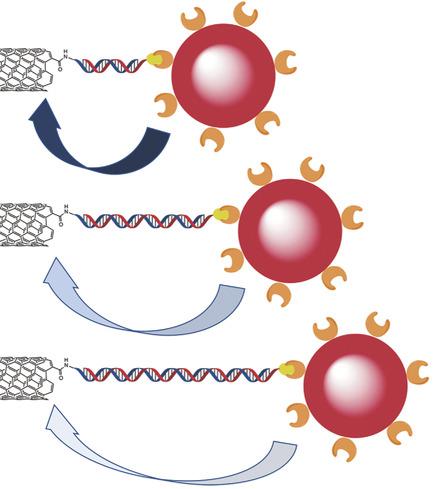Our official English website, www.x-mol.net, welcomes your
feedback! (Note: you will need to create a separate account there.)
Tuning the Coupling in Single‐Molecule Heterostructures: DNA‐Programmed and Reconfigurable Carbon Nanotube‐Based Nanohybrids
Advanced Science ( IF 14.3 ) Pub Date : 2018-08-14 , DOI: 10.1002/advs.201800596 Mark Freeley 1 , Antonio Attanzio 1 , Alessandro Cecconello 1 , Giuseppe Amoroso 1, 2 , Pierrick Clement 1 , Gustavo Fernandez 2 , Felice Gesuele 3 , Matteo Palma 1
Advanced Science ( IF 14.3 ) Pub Date : 2018-08-14 , DOI: 10.1002/advs.201800596 Mark Freeley 1 , Antonio Attanzio 1 , Alessandro Cecconello 1 , Giuseppe Amoroso 1, 2 , Pierrick Clement 1 , Gustavo Fernandez 2 , Felice Gesuele 3 , Matteo Palma 1
Affiliation

|
Herein a strategy is presented for the assembly of both static and stimuli‐responsive single‐molecule heterostructures, where the distance and electronic coupling between an individual functional nanomoiety and a carbon nanostructure are tuned via the use of DNA linkers. As proof of concept, the formation of 1:1 nanohybrids is controlled, where single quantum dots (QDs) are tethered to the ends of individual carbon nanotubes (CNTs) in solution with DNA interconnects of different lengths. Photoluminescence investigations—both in solution and at the single‐hybrid level—demonstrate the electronic coupling between the two nanostructures; notably this is observed to progressively scale, with charge transfer becoming the dominant process as the linkers length is reduced. Additionally, stimuli‐responsive CNT‐QD nanohybrids are assembled, where the distance and hence the electronic coupling between an individual CNT and a single QD are dynamically modulated via the addition and removal of potassium (K+) cations; the system is further found to be sensitive to K+ concentrations from 1 pM to 25 × 10−3m. The level of control demonstrated here in modulating the electronic coupling of reconfigurable single‐molecule heterostructures, comprising an individual functional nanomoiety and a carbon nanoelectrode, is of importance for the development of tunable molecular optoelectronic systems and devices.
中文翻译:

调节单分子异质结构中的耦合:DNA 编程和可重构碳纳米管纳米杂化物
本文提出了一种组装静态和刺激响应单分子异质结构的策略,其中单个功能纳米部分和碳纳米结构之间的距离和电子耦合通过使用 DNA 连接体进行调节。作为概念验证,1:1 纳米混合体的形成受到控制,其中单个量子点 (QD) 通过不同长度的 DNA 互连连接到溶液中单个碳纳米管 (CNT) 的末端。溶液中和单一混合水平上的光致发光研究证明了两种纳米结构之间的电子耦合;值得注意的是,随着连接子长度的缩短,电荷转移成为主要过程,观察到这种现象逐渐扩大。此外,组装了刺激响应的 CNT-QD 纳米杂化物,其中单个 CNT 和单个 QD 之间的距离和电子耦合通过钾 (K + ) 阳离子的添加和去除进行动态调节;进一步发现该系统对 1 pM 至 25 × 10 -3 m的 K +浓度敏感。这里展示的调节可重构单分子异质结构(包括单个功能纳米部分和碳纳米电极)的电子耦合的控制水平对于可调谐分子光电系统和器件的开发非常重要。
更新日期:2018-08-14
中文翻译:

调节单分子异质结构中的耦合:DNA 编程和可重构碳纳米管纳米杂化物
本文提出了一种组装静态和刺激响应单分子异质结构的策略,其中单个功能纳米部分和碳纳米结构之间的距离和电子耦合通过使用 DNA 连接体进行调节。作为概念验证,1:1 纳米混合体的形成受到控制,其中单个量子点 (QD) 通过不同长度的 DNA 互连连接到溶液中单个碳纳米管 (CNT) 的末端。溶液中和单一混合水平上的光致发光研究证明了两种纳米结构之间的电子耦合;值得注意的是,随着连接子长度的缩短,电荷转移成为主要过程,观察到这种现象逐渐扩大。此外,组装了刺激响应的 CNT-QD 纳米杂化物,其中单个 CNT 和单个 QD 之间的距离和电子耦合通过钾 (K + ) 阳离子的添加和去除进行动态调节;进一步发现该系统对 1 pM 至 25 × 10 -3 m的 K +浓度敏感。这里展示的调节可重构单分子异质结构(包括单个功能纳米部分和碳纳米电极)的电子耦合的控制水平对于可调谐分子光电系统和器件的开发非常重要。









































 京公网安备 11010802027423号
京公网安备 11010802027423号